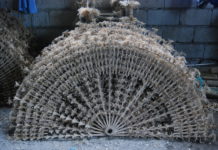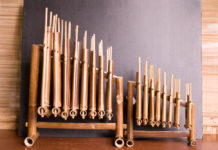Nakjukjang refers to the skill of carving pictures or words into a piece of bamboo by scorching it with a red-hot iron. Nakjuk, or bamboo pyrography, was once used by public officials as a means of putting their seal on their belongings. The process then evolved into a surface decoration technique, whereby a type of branding iron is heated in a brazier using fine tree charcoal and then pressed into the bamboo. If the iron is too hot, it burns the bamboo, if the iron is too cold, then the patterns will not be clear. As the artisans must carve figures at a certain temperature and finish the work before the red-hot iron cools off, they need considerable experience and quick hands.
Nakjuk is used to make decorative designs or patterns an arrow shafts, acupuncture needle boxes, sword grips, folding screens, tobacco pipes, folding fans and bamboo cases for writing brushes. Shapes of butterflies are often used in handheld folding fans, with shapes of bats sometimes used as well. The demand for objects containing bamboo pyrography has decreased noticeably.
Nakjukjang (‘Master Artist of Nakjuk Art’) Kim Gi-chan was introduced to the art of nakjuk while staying in Songgwangsa Temple, one of the three most important Buddhist temples in Korea. He learnt this skills from Yi Dong-ryeon

The iron heated in fire pot of pine tree charcoal fire. It’s important to control of the temperature of iron because when too hot iron it burn the bamboo, and when not warm enough the iron it no longer can carve the pattern. So it needs skills and speed controls.




